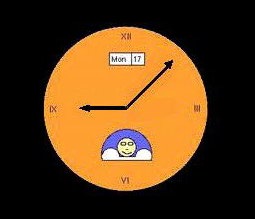
COMP LIT 65/MATH 5
COURSE INFORMATION
SYLLABUS
READING GUIDE
PHOTO ALBUM
FRIDAY DISCUSSIONS
|

-What Time is it? Some Answers The official US time: The site states that: This public service is provided by the Time and Frequency Division of the National Institute of Standards and Technology (NIST). Some interesting sites: The above site gives a list of links concerning time. Today's Calendar and Clock Page: Every answer you could think of. This page gives you the date and time according to both traditional and non-traditional systems, from Gregorian and Chinese to Mayan and Aztec. Links are provided to calendar pages which use systems from around the world, accross cultures, and through time. Very complete. The Times of Our Lives: This page introduces Socio-chronology, the study of the many perspectives in which humans accross cultures experience time. Times Across the World: Current local times accross the world are given. The Official Source of Time Used in the United States: "The Department of the Navy serves as the country's official timekeeper, with the Master Clock facility at the Washington Naval Observatory." &emdash;National Defense Authorization Act for Fiscal Years 1992 and 1993. This page is the home page of the Time Service Department. -Calendars
ISO 8601: A summary of the international standard for date and time notation. Helpful in particular for transnational, scientific discourse. The Calendar Zone -- Bringing Order to Calendrical Chaos!: "Comprehensive categorized calendar catalog currently containing countless correlating connections & calzone recipes!" Calendar (Wolfram Research): A brief history of the calendar with linked references, both internal for depth and external for further exploration. Hermetic Systems: Focuses upon the use of calendar systems, with links to conversion software. Calendar Links: A collection of links for further exploration. Zapotec Calendar/Calendario Zapoteco: A bilingual exploration of the Zapotec Calendar. -Horology : Theory & Practice Horology - The Index ( Clock Watch and Time Museums) A worldwide list: This site contains internal links which give a complete overview of horology, the study of time and timekeeping. Heroes of Horology: Take a look at what they looked like. No text. Newsgroup: Via Usenet, alt.horology. Much of the discussion focuses on restoration and the general business of clocks. Still, the list is interactive, as all lists, providing opportunity to express opinions and ask questions. -History of Clocks A Walk Through Time: A brief stroll through the history of timekeeping. This page was designed by the National Institute of Standards and Technology (NIST) to trace the evolution of timekeeping from ancient devices to their own, contemporary calibrations. Greeks: Thales to Ptolemy: History of timekeeping and its devices in ancient Greece. -Evolution of the Scientific Understanding of Time Stephen Hawking's Universe: A good site for exploring the physical nature of the universe. Hawking says that he will address questions such as: "Where do we come from? How did the universe begin? Why is the universe the way it is? How will it end?" Museo della Specola: English version of the home page for Museo della Specola. This page includes internal links to text on the history of atronomical discover, with particular focus on that history in Bologne, Italy. Very useful in tracing the intellectual history of scientific discovery relating to time and time measurement.
Einstein Exhibit: Maintained by the American Institute of Physics, this site contains some interesting material on Einstein, from original papers to a recording of him explaining his famous formula stating the equivalence of mass and energy. Time Distinctions (Wolfram Research): This page gives many definitions related to time and astronomy. Each definition given links to a more extended, cross-referenced definition. Good for comparison and clarification. -Biological Timing The Center for Biological Timing: This consortium, based at the University of Virginia, maintains a website devoted to circadian clocks, including their history. You can find there a discussion of the biomathematics of clocks, as well as a review of the pathbreaking breakthroughs that came in 1998. -The Fourth Dimension A Hypercube: In this website we find a Hypercube cut open and represented in 3-space. A Collection of Hyper-Dimensional Links : It contains an extensive list of links and Java Applets.
-Time Travel A Course in Time Travel: A 28-lesson course on how to become a time traveler, including meditation and progressive techniques. Hyper Dimensional Resonator, sold here: This website offers the Hyper Dimensional Resonator: a device that will allow you, or so they claim, to travel into the past or explore the future. Time travel in the Movies: This website lists movies that explore the possibilities of time travel.
-Articles of Interest
Einstein's Hot Time (Scientific American, September 2002): Reference to an article by Einstein in which he claims that: "When a man sits with a pretty girl for an hour, it seems like a minute. But let him sit on a hot stove for a minute and it's longer than an hour. That's relativity." Physicists do not agree with his conclusion that "That's relativity." But the article provides food for thought.
|
Please report any out-of-date links or make suggestions of sites to add.